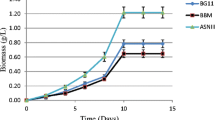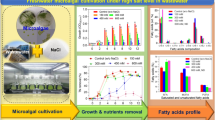Abstract
Four microalgal strains, namely, Tetraselmis indica (T. indica), Scenedesmus abundans (S. abundans), Spirulina sp., and Nostoc muscorum (N. muscorum) were cultivated on four different wastewaters in 1000 ml photobioreactors with 750 ml working volume under 94.5 μmol m−2 s−1 light intensity for 14 days for phycoremediation of wastewaters and sustainable biodiesel production. These microalgal strains attained maximum biomass growth in the secondary treated sewage (STS). Maximum biomass yield (0.6533 g L−1) and lipid productivity (25.44 mg L−1 d−1) for T. indica were achieved in STS. T. indica removed (63.6–78.24%) of nitrate, (60.90–65.97%) of phosphate, (61.01–80.01%) of ammonical nitrogen, and (71.16–85.70%) of total organic carbon (TOC) in all four wastewaters. The fatty acid methyl ester (FAME) profile of T. indica shows the presence of myristic acid (1.2%) pentadecylic acid (0.28%), palmitic acid (10.32%), oleic acid (34.59%), linoleic acid (12.38%), and eicosanoic acid (14.88%) in STS. This study demonstrates that T. indica is the most suitable microalgal species among the four microalgal strains selected for phycoremediation of wastewaters and higher biomass production for sustainable biodiesel production.




Similar content being viewed by others
References
Abou-Shanab RAI, Ji MK, Kim HC, Paeng KJ, Jeon BH (2013) Microalgal species growing on piggery wastewater as a valuable candidate for nutrient removal and biodiesel production. J Environ Manag 115:257–264. https://doi.org/10.1016/j.jenvman.2012.11.022
Abou-Shanab RAI, El-Dalatony MM, El-Sheekh MM et al (2014) Cultivation of a new microalga, Micractinium reisseri, in municipal wastewater for nutrient removal, biomass, lipid, and fatty acid production. Biotechnol Bioprocess Eng 19:510518. https://doi.org/10.1007/s12257-013-0485-z
Amit, Chandra R, Ghosh UK, Nayak JK (2017) Phycoremediation potential of marine microalga Tetraselmis indica on secondary treated domestic sewage for nutrient removal and biodiesel production. Environ Sci Pollut Res 24:20868–20875. https://doi.org/10.1007/s11356-017-9734-6
APHA (1992) Standard methods for the examination of water and wastewater. Water Environ Fed 18th:9–45
Araujo GS, Matos LJBL, Gonçalves LRB, Fernandes FAN, Farias WRL (2011) Bioresource technology bioprospecting for oil producing microalgal strains : evaluation of oil and biomass production for ten microalgal strains. Bioresour Technol 102:5248–5250. https://doi.org/10.1016/j.biortech.2011.01.089
Arora N, Patel A, Sartaj K, Pruthi PA, Pruthi V (2016) Bioremediation of domestic and industrial wastewaters integrated with enhanced biodiesel production using novel oleaginous microalgae. Environ Sci Pollut Res 23:1–11. https://doi.org/10.1007/s11356-016-7320-y
Barnwal BK, Sharma MP (2005) Prospects of biodiesel production from vegetable oils in India. Renew Sustain Energy Rev 9:363–378. https://doi.org/10.1016/j.rser.2004.05.007
Bhatnagar A, Chinnasamy S, Singh M, Das KC (2011) Renewable biomass production by mixotrophic algae in the presence of various carbon sources and wastewaters. Appl Energy 88:3425–3431. https://doi.org/10.1016/j.apenergy.2010.12.064
E. G. Bligh and W. J. Dyer ARMOTLEAP (1959) Canadian Journal of Biochemistry and Physiology. 37:
Chakraborty S, Mohanty D, Ghosh S, Das D (2016) Improvement of lipid content of Chlorella minutissima MCC 5 for biodiesel production. J Biosci Bioeng 122:294–300. https://doi.org/10.1016/j.jbiosc.2016.01.015
Chen M, Tang H, Ma H, Holland TC, Ng KYS, Salley SO (2011) Effect of nutrients on growth and lipid accumulation in the green algae Dunaliella tertiolecta. Bioresour Technol 102:1649–1655. https://doi.org/10.1016/j.biortech.2010.09.062
Gani P, Sunar NM, Matias-Peralta H et al (2016a) Influence of initial cell concentrations on the growth rate and biomass productivity of microalgae in domestic wastewater. Appl Ecol Environ Res 14:399–409. https://doi.org/10.15666/aeer/1402_399409
Gani P, Sunar NM, Matias-Peralta HM, Latiff AAA, Parjo UK, Embong Z, Khalid A, Tajudin SAA (2016b) The potential of biodiesel production from Botryococcus sp. biomass after phycoremediation of domestic and industrial wastewater. IOP Conf Ser Mater Sci Eng 160:0–9. https://doi.org/10.1088/1757-899X/160/1/012048
Gani P, Sunar NM, Matias-Peralta H, Mohamed RMSR, Latiff AAA, Parjo UK (2017) Extraction of hydrocarbons from freshwater green microalgae (sp.) biomass after phycoremediation of domestic wastewater. Int J Phytorem 19(7):679–685
Gupta PL, Choi HJ, Pawar RR, Jung SP, Lee SM (2016) Enhanced biomass production through optimization of carbon source and utilization of wastewater as a nutrient source. J Environ Manag 184:585–595. https://doi.org/10.1016/j.jenvman.2016.10.018
Kim G, Bae J, Lee K (2016) Nitrate repletion strategy for enhancing lipid production from marine microalga Tetraselmis sp. Bioresour Technol 205:274–279. https://doi.org/10.1016/j.biortech.2016.01.045
Knothe G (2009) Improving biodiesel fuel properties by modifying fatty ester composition †. 759–766. doi: https://doi.org/10.1039/b903941d
Kumar D, Santhanam P, Jayalakshmi T, et al (2015) Excessive nutrients and heavy metals removal from diverse wastewaters using marine microalga Chlorella marina ( Butcher ) 44:
Ledda C, Idà A, Allemand D, Mariani P, Adani F (2015) Production of wild Chlorella sp. cultivated in digested and membrane-pretreated swine manure derived from a full-scale operation plant. Algal Res 12:68–73. https://doi.org/10.1016/j.algal.2015.08.010
Lekshmi B, Joseph RS, Jose A, Abinandan S, Shanthakumar S (2015) Studies on reduction of inorganic pollutants from wastewater by Chlorella pyrenoidosa and Scenedesmus abundans. Alexandria Eng J 54:1291–1296. https://doi.org/10.1016/j.aej.2015.09.013
Liu J, Huang J, Sun Z, Zhong Y, Jiang Y, Chen F (2011) Differential lipid and fatty acid profiles of photoautotrophic and heterotrophic Chlorella zofingiensis: assessment of algal oils for biodiesel production. Bioresour Technol 102:106–110. https://doi.org/10.1016/j.biortech.2010.06.017
Mata TM, Martins AA, Caetano NS (2010) Microalgae for biodiesel production and other applications: a review. Renew Sust Energ Rev 14:217–232. https://doi.org/10.1016/j.rser.2009.07.020
Medeiros DL, Sales EA, Kiperstok A (2015) Energy production from microalgae biomass: carbon footprint and energy balance. J Clean Prod 96:493–500. https://doi.org/10.1016/j.jclepro.2014.07.038
Michels MHA, Vaskoska M, Vermuë MH, Wijffels RH (2014) Growth of Tetraselmis suecica in a tubular photobioreactor on wastewater from a fish farm. Water Res 65:290–296. https://doi.org/10.1016/j.watres.2014.07.017
Montero MF, Manuela A, Guillermo GR (2011) Isolation of high-lipid content strains of the marine microalga Tetraselmis suecica for biodiesel production by flow cytometry and single-cell sorting. J Appl Phycol 23(6):1053–1057
Rai MP, Gupta S (2016) Effect of media composition and light supply on biomass, lipid content and FAME profile for quality biofuel production from Scenedesmus abundans. Energy Convers Manag 141:85–92. https://doi.org/10.1016/j.enconman.2016.05.018
Reyimu Z, Ozçimen D€ (2017) Batch cultivation of marine microalgae Nannochloropsis oculata and Tetraselmis suecica in treated municipal wastewater toward bioethanol production. J Clean Prod 150:40–46. https://doi.org/10.1016/j.jclepro.2017.02.189
Sharma GK, Khan S, Ahmad F, Gupta N (2014) Nutrient sequestration and phycoremediation of sewage waste water by selective microalgae. Green Farming 5:1–4
Sirin S, Sillanpää M (2015) Cultivating and harvesting of marine alga Nannochloropsis oculata in local municipal wastewater for biodiesel. Bioresour Technol 191:79–87. https://doi.org/10.1016/j.biortech.2015.04.094
Sirakov IN, Velichkova KN (2014) Bioremediation of wastewater originate from aquaculture and biomass production from microalgae species-Nannochloropsis oculata and Tetraselmis chuii. Bulg. J. Agric. Sci 20:66–72
Sydney EB, da Silva TE, Tokarski A, Novak AC, de Carvalho JC, Woiciecohwski AL, Larroche C, Soccol CR (2011) Screening of microalgae with potential for biodiesel production and nutrient removal from treated domestic sewage. Appl Energy 88:3291–3294. https://doi.org/10.1016/j.apenergy.2010.11.024
Wu LF, Chen PC, Lee CM (2013) The effects of nitrogen sources and temperature on cell growth and lipid accumulation of microalgae. Int Biodeterior Biodegradation 85:506–510. https://doi.org/10.1016/j.ibiod.2013.05.016
Yang IS, Salama ES, Kim JO, Govindwar SP, Kurade MB, Lee M, Roh HS, Jeon BH (2016) Cultivation and harvesting of microalgae in photobioreactor for biodiesel production and simultaneous nutrient removal. Energy Convers Manag 117:54–62. https://doi.org/10.1016/j.enconman.2016.03.017
Zhu L, Wang Z, Shu Q, Takala J, Hiltunen E, Feng P, Yuan Z (2013) Nutrient removal and biodiesel production by integration of freshwater algae cultivation with piggery wastewater treatment. Water Res 47:4294–4302. https://doi.org/10.1016/j.watres.2013.05.004
Acknowledgements
The authors are thankful to Ministry of Human Resource and Development, Government of India, for providing research grant for this work.
Author information
Authors and Affiliations
Corresponding author
Additional information
Responsible editor: Philippe Garrigues
Highlights
• The higher biomass productivity was showed in STS by T. indica.
• Screening of most suitable microalgae in four different wastewaters for higher biomass production.
• T indica was found to be most promising species for nutrients removal and biodiesel production.
• T. indica biodiesel profile is within the specified ASTM D6751 standards.
Rights and permissions
About this article
Cite this article
Amit, Ghosh, U.K. An approach for phycoremediation of different wastewaters and biodiesel production using microalgae. Environ Sci Pollut Res 25, 18673–18681 (2018). https://doi.org/10.1007/s11356-018-1967-5
Received:
Accepted:
Published:
Issue Date:
DOI: https://doi.org/10.1007/s11356-018-1967-5




